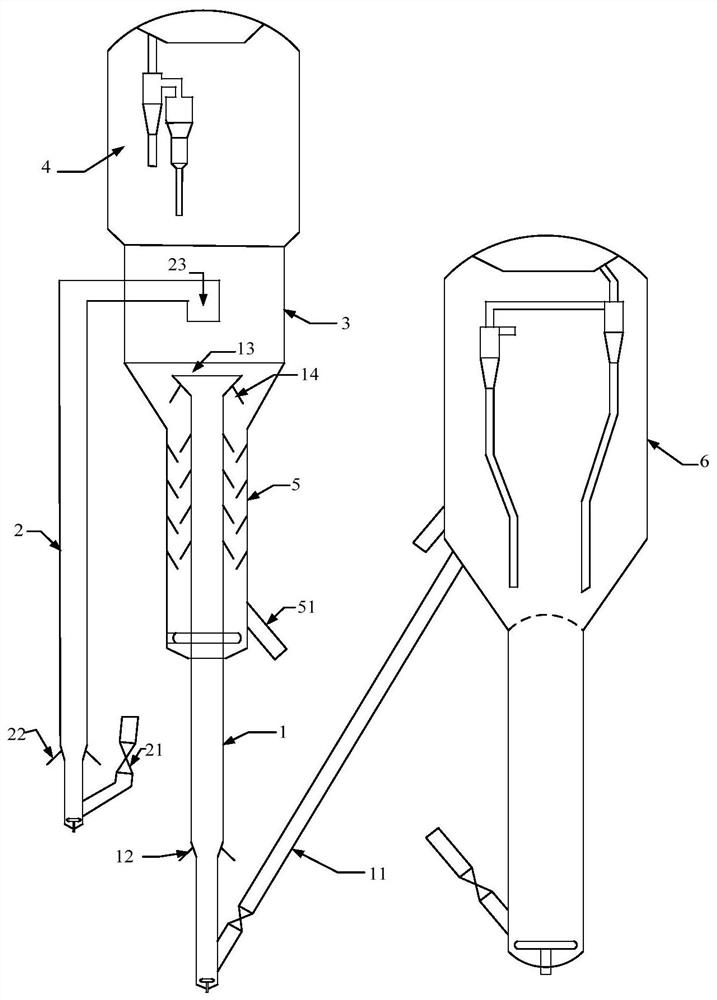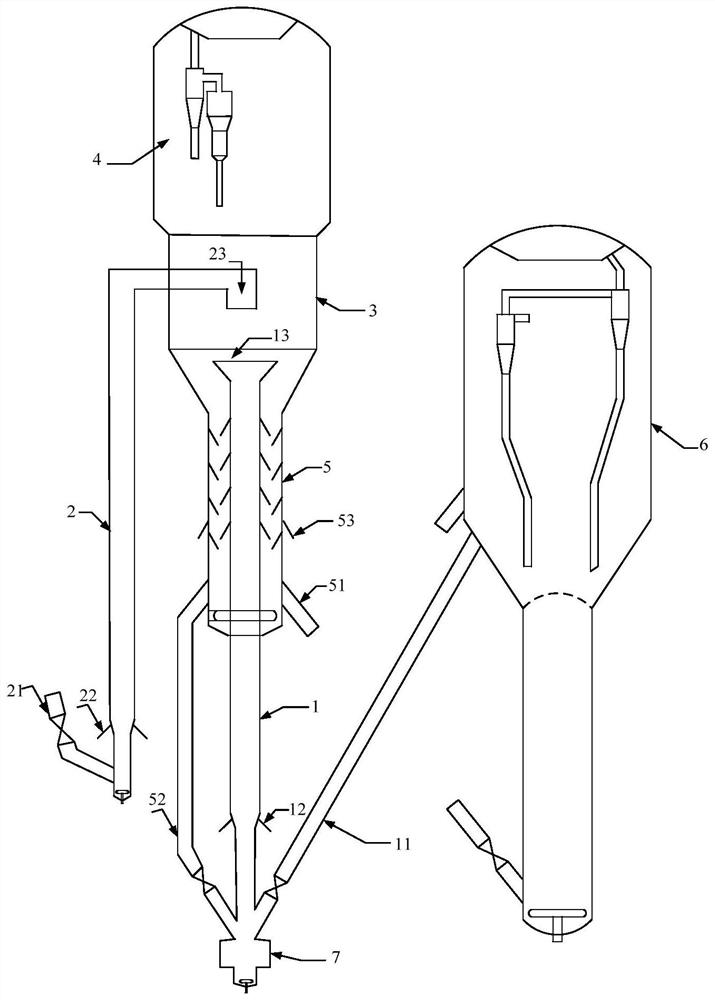Method for producing propylene by catalytic cracking of hydrocarbons
A catalytic cracking and catalytic cracking technology, which is applied in the production of bulk chemicals, hydrocarbon cracking to produce hydrocarbons, and hydrocarbon oil treatment products, etc., can solve problems such as increasing the processing amount of light hydrocarbons, increasing coke yield, and reducing propylene yield
- Summary
- Abstract
- Description
- Claims
- Application Information
AI Technical Summary
Problems solved by technology
Method used
Image
Examples
Embodiment approach
[0033] According to a preferred embodiment of the present invention, the mass ratio of the first regenerated catalyst to the second regenerated catalyst is 2-4:1. Adopting this preferred embodiment is more conducive to producing more propylene.
[0034] According to the present invention, preferably, the operating conditions of the first riser reactor include: the solvent-oil ratio is 8-20, the oil-gas residence time is 0.5-5s, and the outlet temperature is 550-580°C; preferably, the solvent-oil ratio 10-20, the oil and gas residence time is 0.8-2s, and the outlet temperature is 550-570°C.
[0035] According to the present invention, preferably, the operating conditions of the second riser reactor include: the outlet temperature is 610-650°C, the oil and gas residence time is 0.1-4s; more preferably, the outlet temperature is 620-630°C, and the oil and gas residence time The time is 0.5-3s.
[0036] In the present invention, the operating conditions of the fluidized bed reac...
Embodiment 1
[0062] Experiments were carried out using a modified medium-sized device for continuous reaction-regeneration operation, and the process flow is as follows figure 1 Shown, the inner diameter of the first riser reactor 1 of this medium-sized device is 16 millimeters, and the length is 3800 millimeters, and the inner diameter of the second riser reactor 2 is 12 millimeters, and the length is 3200 millimeters, and the inner diameter of the fluidized bed reactor 3 is 64 mm and a height of 600 mm. The high-temperature regenerated catalyst at 700°C is respectively introduced into the bottom of the first riser reactor 1 and the second riser reactor 2 through the first regenerated catalyst delivery pipe 11 and the second regenerated catalyst delivery pipe 21 from the regenerator 6, and is The steam flows upwards. After the heavy raw oil is mixed with atomized water vapor, it enters the first riser reactor 1 through the first feed nozzle 12 to contact with the hot regenerant for catal...
Embodiment 2
[0073] Experiments were carried out using a modified medium-sized device for continuous reaction-regeneration operation, and the process flow is as follows figure 2 Shown, the inner diameter of the first riser reactor 1 of this medium-sized device is 16 millimeters, and the length is 3800 millimeters, and the inner diameter of the second riser reactor 2 is 12 millimeters, and the length is 3200 millimeters, and the inner diameter of the fluidized bed reactor 3 is 64 mm and a height of 600 mm. The bottom of the first riser reactor 1 is provided with a catalyst mixer 7, and the high-temperature regenerated catalyst at 690° C. is introduced into the catalyst mixer through the first regenerated catalyst delivery pipe 11, and part of the ungenerated catalyst is introduced into the catalyst mixer through the ungenerated catalyst circulation pipe 52. Upward flow with pre-lift steam. After the heavy raw oil is mixed with atomized water vapor, it enters the first riser reactor 1 thro...
PUM
| Property | Measurement | Unit |
|---|---|---|
| Average pore size | aaaaa | aaaaa |
Abstract
Description
Claims
Application Information
 Login to View More
Login to View More - R&D
- Intellectual Property
- Life Sciences
- Materials
- Tech Scout
- Unparalleled Data Quality
- Higher Quality Content
- 60% Fewer Hallucinations
Browse by: Latest US Patents, China's latest patents, Technical Efficacy Thesaurus, Application Domain, Technology Topic, Popular Technical Reports.
© 2025 PatSnap. All rights reserved.Legal|Privacy policy|Modern Slavery Act Transparency Statement|Sitemap|About US| Contact US: help@patsnap.com



